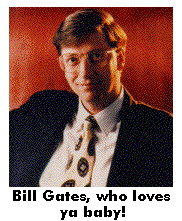

Most advertsing agencies in Australia and around the world have made their mark by producing for their clients innovative, visually (or vocally) original concepts. The tone, style and impact are still as important as ever. Now, however, there are several additional factors to take into consideration. Interactivity, new media technology, ease of use and overall design interface are the new terms that the adverting world must now come to grips with.
"Adapting is always difficult." expains Rod." Usually one visionary attempts to lead the blind into the shining light of interactive multimedia, with varying results. This is why large agencies are finding it bloody tough - too many people stuck in their departmental ways. Small organisations can sometimes do it better simply because there is less resistance to overcome internally.
I feel it's now vital to create networks or alliances. You simply can't be master of all trades in the emerging media, because the trades are being redefined by the hour. Best to work with like-minded advisors, freelances, colleagues and technical boffins to create great stuff."
So, is the 'in-house' method not the way to go?
"In-house can be a dirty phrase. Big agencies are suddenly specialists in multimedia with their in-house people. If I was a client I'd want the best, not the in-house people who may simply toe the agency's corporate line instead of tipping a few sacred cows on their heads and spraying them with hypergraffiti."
The terms 'educational' and 'fun' have not exactly been instantly associated with the advertisments of today, especially on the internet. What you usually get on the net is a bombardment of boring company profile pages, with speels as long as the highway itself. 'Click here to See our $$prices$$ page' is usually the first or second link on a commercial site. And so it is here that perhaps the terms 'educational' and 'fun' can shine through.
 "Logging into a big theme line", says Rod Smith, "is about as exciting as Bill Gates' jokes during his recent seminars (you're such a bitch, Rod!). But logging into a 3D image of a Civic VTi, clicking on the bonnet to reveal a hypertext link to another section on engine size, speed and power complete with sound samples and animation, is educational and sheer fun!"
"Logging into a big theme line", says Rod Smith, "is about as exciting as Bill Gates' jokes during his recent seminars (you're such a bitch, Rod!). But logging into a 3D image of a Civic VTi, clicking on the bonnet to reveal a hypertext link to another section on engine size, speed and power complete with sound samples and animation, is educational and sheer fun!"
Okay, so it might be nice to look through and explore a brand new Civic, but how on earth would an advertising agency apply the same concept to something as mundane as, say, cat food? Rod Smith has a few ideas.
"Cat food.... click on the lid. It opens, fish pop out. Click to enlarge. Tails and heads dissolve into a trashcan. New screen comparing oiliness of the 7 most used species. Processing methods - does ours  use driftnetting which could trap dolphins? No way. Cat Statistics: how many die of heart disease? Why oil kills cats, too. Aluminium cans vs steel. Our new compacting plant that creates non-dioxin land fills. Recycled paper packaging (Web page with recycled background!). Breeder's column with hot goss (what the experts use....)".
use driftnetting which could trap dolphins? No way. Cat Statistics: how many die of heart disease? Why oil kills cats, too. Aluminium cans vs steel. Our new compacting plant that creates non-dioxin land fills. Recycled paper packaging (Web page with recycled background!). Breeder's column with hot goss (what the experts use....)".
I'm glad I asked that question! I guess if we can make catfood interesting, nothing is net proof, right?
"Just like traditional briefs" adds Rod, "we need to interrogate the product. There is no boring cat food. There are only boring writers who write about it."